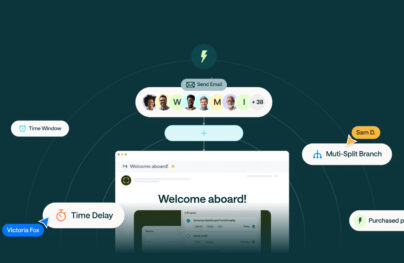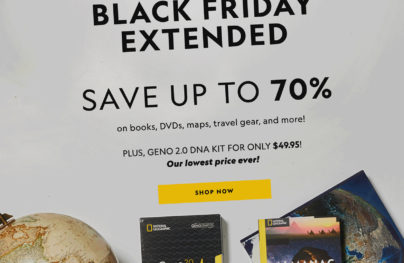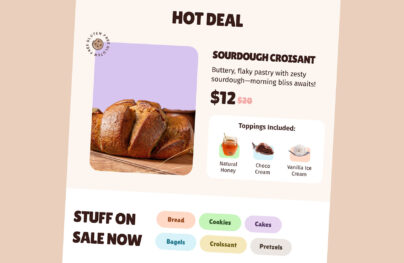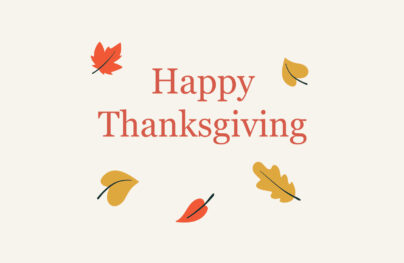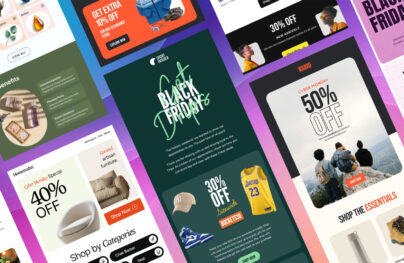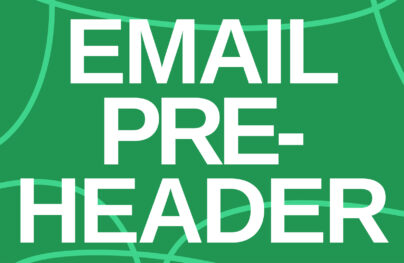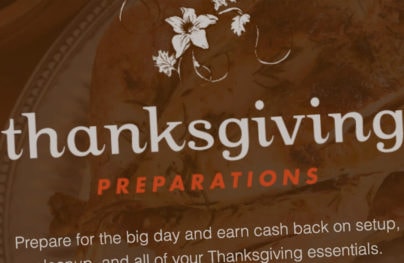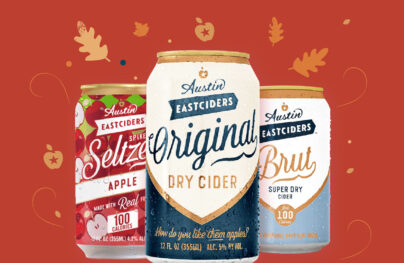How to Start a Paid Newsletter Subscription
Paid newsletters are more than a trend; they are a viable way for writers, creators, and entrepreneurs to generate consistent income. With the rise of subscription-based content models, starting a paid newsletter allows you to monetize your expertise while building a loyal audience.
Monetizing your knowledge and skills is nothing new. Professionals across niches share their wisdom and experience through online courses, coaching, consulting, tutorials, e-books, and paid newsletters. Among this diversity of approaches, delivering premium subscription-based content through email channels has become increasingly popular, as most content creators believe it to be their most important digital revenue stream.
This business model is a great way to establish yourself as an expert without much expense. It builds community around your expertise, eventually turning your personality into a brand. Plus, it generates much-needed recurring income to support your passion.
As people crave high-quality, authentic, and exclusive material, the flexible, unpretentious, and budget-friendly paid newsletter model might become your solution to meet their demands and realize your goals.
So, how do you launch a paid newsletter and translate your unique knowledge and skill into a viable product worthy of recurring payment?
In this guide, we’ll walk you through the steps to successfully launch a paid newsletter subscription, offering practical insights, proven strategies, and real-world tips to ensure your newsletter stands out.
With Postcards Email Builder you can create and edit email templates online without any coding skills! Includes more than 100 components to help you create custom emails templates faster than ever before.
Free Email BuilderFree Email TemplatesKnown as a subscription or a premium newsletter, a paid newsletter is a type of digital correspondence created by a person, team, or company that people pay to receive through an email channel. The recurring fee is charged monthly or yearly.
A paid newsletter includes exclusive content, offers, or unique value that cannot be found in free emails sent by the same creator. As a direct connection between subscribers and creators, it is also a great marketing tool that offers numerous benefits. It can build personal brand identity, reinforce positioning in the market, increase credibility and trust, underlie a solid foundation for other marketing strategies, and supplement income.
Depending on the niche, target audience, goal, strategy, and, most importantly, knowledge and experience the creator wants to share with their fan base, a paid newsletter can deliver all kinds of content. The most popular of them are:
Learning Material
Learning material is perhaps one of the most popular types of content creators provide, as it is a time-proven way to share knowledge and expertise in the field. It is usually presented as tutorials, guides, how-to articles, courses, or e-books.
This educational content aims to help the target audience deepen their knowledge, grab tricky concepts, enhance their understanding of a subject, develop new skills, and solve specific problems.
Case Studies
Case studies are another popular type of content that subscribers may pay for. They provide valuable insights into business, niche, or topic. They offer readers robust qualitative data analysis based on real-time research, which generates an in-depth, multi-faceted understanding of a complex issue. They are particularly useful in many situations and come as true exclusive content.
Trends and Market Reports
Like case studies, trend forecasts and market reports are exclusive content unavailable elsewhere. They require knowledge, skills, and experience to examine, evaluate, and summarize trends in the respective field.
This material helps readers stay current in their fields and obtain relevant information to make calculated decisions. It also helps the creator establish authority in the niche and reinforce their brand identity.
With Startup App and Slides App you can build unlimited websites using the online website editor which includes ready-made designed and coded elements, templates and themes.
Try Startup App Try Slides AppOther ProductsInterviews and Podcasts
Interviews and podcasts are costly, time-consuming, and labor-intensive approaches to fetching valuable data from exclusive sources. Creators navigate numerous challenges, from perfecting the technical side to creating captivating show notes. Whether discussing a relevant topic or talking with experts in the field, this content is considered unique material.
Questions and Answers
Questions and answers are a common form of educational material in paid newsletters. They provide clear, informative, and accessible answers to the most burning questions. Creators use them to alleviate subscribers’ frustration by providing quick and concise solutions to problems so they can troubleshoot issues independently.
Personalized Coaching and Advice

Unlike conventional coaching, personalized advice and consultations provide better and more effective assistance in achieving goals. Professionals create hyper-personalized plans for each individual, use paid newsletters to manage each step, and ipso facto form mentor-mentee relationships. This strategy is common for fitness and well-being niches.
Member-Only Events
Events like webinars, live streams, live coaching, conferences, meetings, and Q&A sessions are increasingly popular among readers. They give participants a sense of community, exclusivity, and belonging. They offer networking opportunities, engaging with like-minded people, and conducting meaningful conversations. Paid newsletters are a great platform for introducing them to the crowd and promoting their benefits.
Early Access and Sneak Peeks
Early access is a common marketing strategy that allows loyal fans to enjoy new products, features, or services before they are available to the general public. By offering a sneak peek or special deal, owners of paid newsletters create a sense of exclusivity and excitement. They cultivate appreciation among readers, who feel valued and rewarded for loyalty.
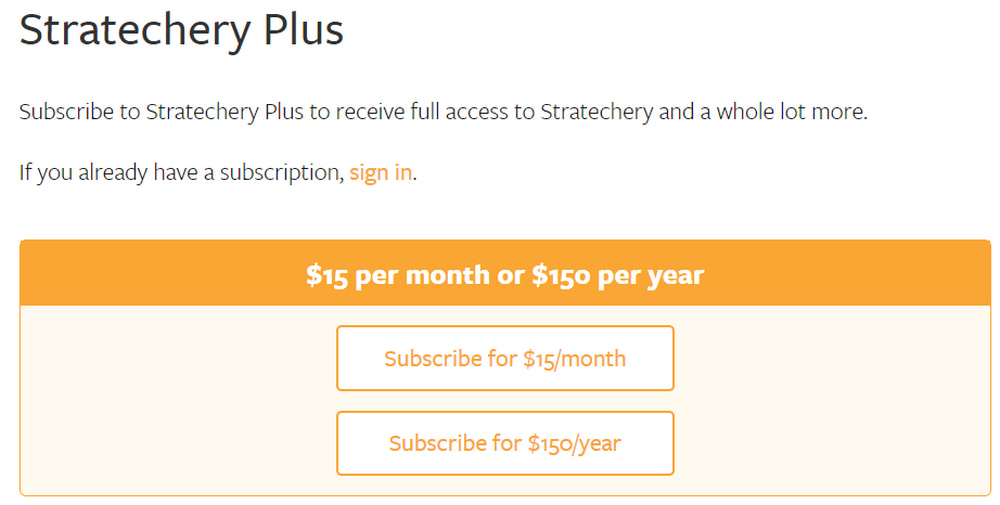
Stratechery Plus (paid subscription by Ben Thompson)
Premium subscriptions have become a popular way to monetize expertise and intelligence in 2024. Statista says entrepreneurs across niches identify premium subscription-based content as the most important digital revenue stream.
Although generating a decent amount of money takes time, patience, and total devotion, even a small automatic recurring income supplements an entrepreneur’s passion and allows them to create exclusive content for their audience.
Beyond the potential to earn substantial money from doing things you love and know, here are other good reasons to launch a paid newsletter subscription.
Build Personal Brand
As the community of solopreneurs and influencers steadily grows, turning your personality into a brand has become a surefire way to establish yourself online. It is also the only way to stand out in the market long-term and gain a competitive advantage.
Paid newsletters are what you need to build a strong personal brand for many good reasons.
- They are diverse and multifaceted. You may share any content you want. It could be static or dynamic, self-contained, or include links to member-only access to special events, offers, and features.
- They are responsive, mobile-friendly, and accessible. When created in Postcards email builder, paid newsletters look, feel, and behave consistently across devices, operating systems, screen sizes, and mailbox providers. They deliver the exact message you want to every inbox without any distortion.
- They are increasingly flexible. Whether you want to share your hardly-earned experience or help your readers to make informed decisions with the most recent studies and surveys, they give you tools to present this information in the most pleasant, comfortable way.
- They give you the freedom to write what you want. The most significant advantage of launching a paid newsletter lies in self-realization, as you are not dependent on what your job or sponsor demands. It puts you in the driver’s seat and lets your creative juices flow.
Create Community
The potential of email marketing is huge, as it offers direct access to the targeted market. By connecting with a receptive audience and delivering value with every outreach, creators may build strong and healthy relationships with readers without any control or influence from search engines and social media. They may live up to their expectations, needs, and preferences, increasing their satisfaction with the subscription and gradually turning them into fans.
Encourage Professional Growth
Paid newsletters offer opportunities for professional growth. As you get freedom for realization by earning recurring money to supplement your passion and endeavors, you get more time to exercise creativity, acquire new knowledge and experience, and conduct studies and surveys.
Searching for unique content and gathering relevant and useful information for your subscribers may allow you to extend your knowledge, sharpen your skills, and connect with other professionals. This strengthens your network business and raises your professional profile.
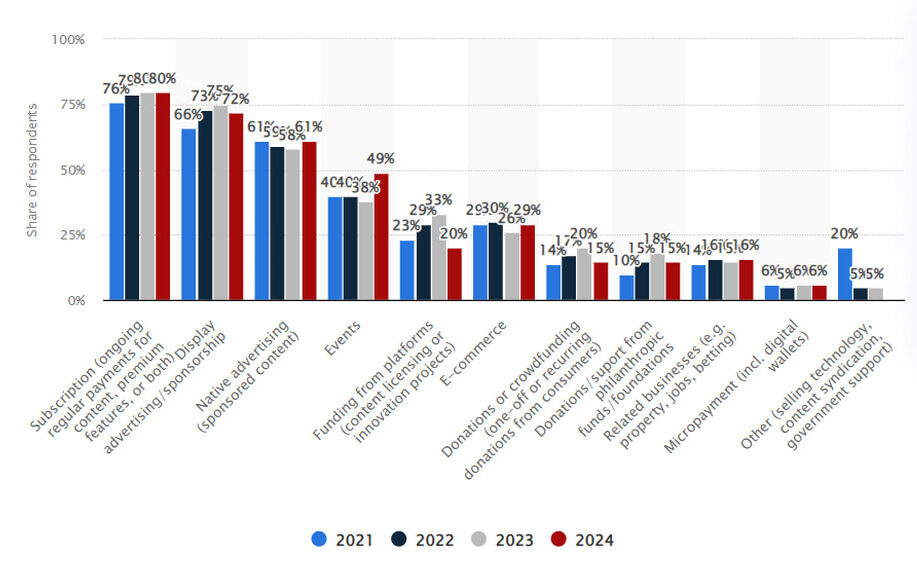
The most important digital revenue streams for publishers in the year ahead, according to industry leaders worldwide, from 2021 to 2024.
There are many reasons and benefits to running a paid newsletter. It is low-entry-level, does not require special technical skills, and is cost-effective. With a reliable ESP and Postcards email builder, anyone can do this and enjoy the true benefits of email marketing, such as generating recurring income, building personal branding, and growing personally and professionally. However, there are several challenges to tackle and common mistakes to avoid.
Acquisition
Entrepreneurs’ biggest obstacle when launching a paid newsletter is building a mailing list. Attracting subscribers and, most importantly, convincing them to pay for the content is a tough task, especially when so much high-quality content is free online.
The solution is to devise a comprehensive marketing strategy. Creators should start by analyzing their market and target audience to thoroughly understand the competitive landscape and subscribers’ preferences, needs, and expectations. Then, they should develop a clear mission and a strong value proposition. Afterward, they must provide their prospects with an easy way to join.
Finally, creators are advised to use marketing tactics such as offering a trial period or a free sample of exclusive content to demonstrate what people will pay for. It would also help to communicate the benefits of subscribing and provide social proof through ratings or feedback. Being transparent is key to building strong relationships with your readers from the point of meeting them.
Retention
Another big challenge is keeping subscribers on board. Customer retention is critical to any business, and the paid subscription model is no exception. Ever-growing customer expectations and fierce market competition prevent many creators from maintaining long-term relationships with readers and ipso facto stable personal growth and recurring revenue.
The key to creating and implementing effective retention strategies lies in many factors. Creators should understand common issues that may increase retention rates and address them proactively. These include poor customer support, lack of personalization in communication, and poor segmentation.
Creators should quickly adapt to subscriber’s needs and preferences. Following trends and providing them with relevant content is vital to prove your value with every outreach.
Creators are advised to adopt some popular email retention marketing campaigns. Rewarding loyal customers is a core difference between you and your competitors. Entice existing readers back with special content, discounts, or opportunities to remind them that they are a part of an exclusive club.
Finally, it is crucial to understand that people get disengaged with content. It is a normal process, and even the niche leaders are not immune to it. You should respect your subscribers’ right to leave. Let them go without hard feelings, but secure a powerful, long-lasting impression of your partnership by sending a thank you note. It would also help to invite your subscribers to other digital channels to follow your work there.
Consistency
Among the biggest challenges that paid newsletter creators experience is consistently producing unique and high-quality content. To succeed, you should regularly send valuable content your subscribers cannot find anywhere else. Otherwise, they will quickly get disengaged and leave your mailing list.
However, creating content, even for a free newsletter, is a time-consuming, resource-intensive process that requires a high level of expertise in the chosen topic. You should commit to your schedule and be devoted to your target audience’s needs. Some of the best advice to pull this through are:
- Have a clear focus for your paid newsletter.
- Do your homework: research for new material, follow trends, and create unique content.
- Present your content in a professional, engaging, and easy-to-read format.
- Use Postcards to create a fully responsive, mobile-friendly, and accessible newsletter.
- Proofread your content. You might hire a professional editor or use professional software like Grammarly.
- Please do not shy away from visuals, animated Gifs, interactive elements, or videos; they enhance user experience and leave a long-lasting positive impression.
- Listen to your audience and adapt your content based on their feedback and interests.
Financial Instability
Financial instability is perhaps one of paid newsletter creators’ most discouraging challenges. The sad truth is that if you are not a well-established newspaper, your paid subscription will have this problem, as lead generation is a slow and daunting process with some step-backs on the way.
As a rule, the first months or even years are marked by unstable and unpredictable recurring income. This might also be affected by the economic environment, stresses in the financial system, events like war outbreaks, etc.
The general advice is to make a realistic budget, invest in professional software, and devise a long-term marketing strategy.
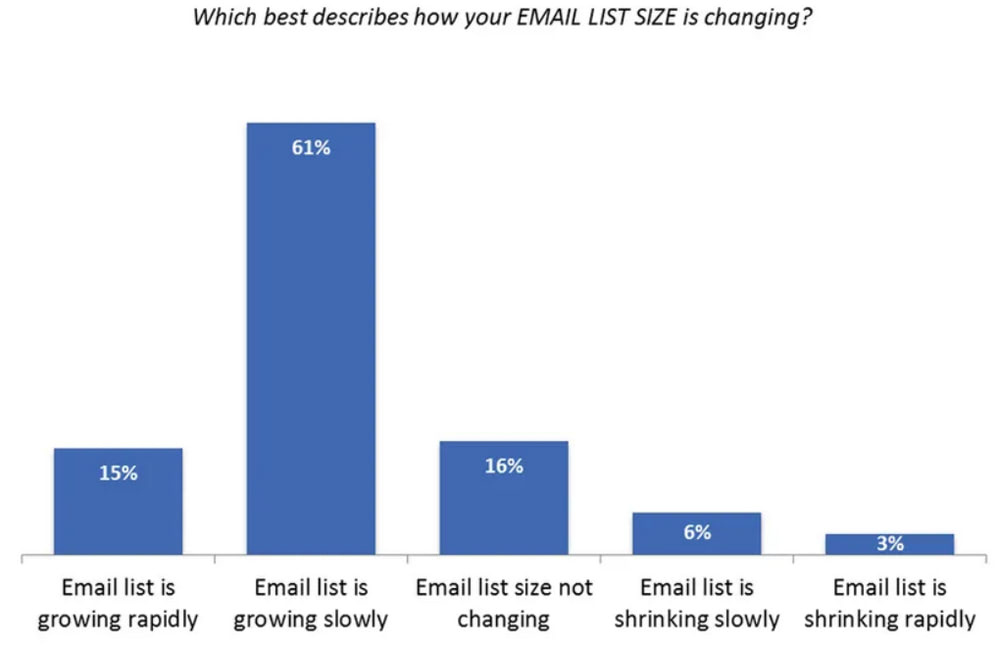
Email List Growth Survey Summary Report by Ascend2 provided by GetResponse
Along with the challenges that creators of paid newsletters face, they are prone to making mistakes. Try to avoid these common errors.
Send “More” Instead of “Different”
Some creators of paid newsletters falsely believe that the more emails they send, the more prolific their business will be. However, in the oversaturated and overserved world of email marketing, users already receive too many digital correspondences to handle it in time. Some surveys say that a person with a professional background gets over 100 digital newsletters daily. Becoming one of those companies that already bombard your subscribers with content will not do the trick.
Finding the right frequency for reaching your subscribers is crucial to separating yourself from the competition and demonstrating respect for the subscriber’s valuable time. It is better to send a few emails yet make them different, delivering value and a meaningful user experience with every outreach.
Avoid Personalization
No one likes a generic approach, especially when paying for it. Everyone wants to feel special. However, many paid newsletter creators forget about being personal during their communication.
Nevertheless, personalization is a key to a subscriber’s heart. It shows them that you acknowledge and understand their wants and needs. It also creates a sense of importance and relevance and heightens a sense of exclusivity. Simply addressing the person by name, defining the right cadence, or providing a unique discount works wonders.
Create Text-Only Emails
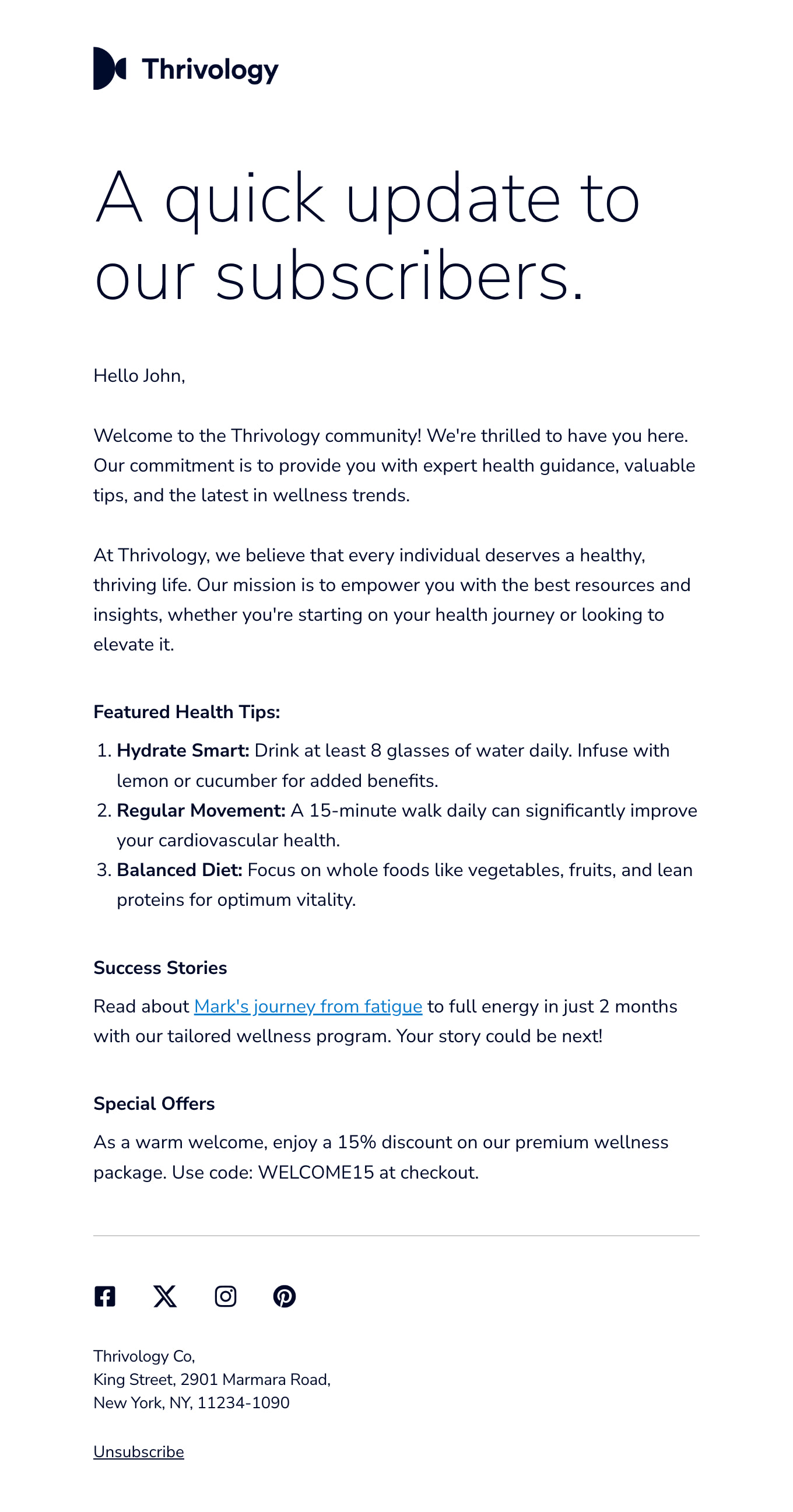
Gone are the days of text-only emails. Today’s mailbox users expect great, meaningful, and unforgettable experiences from digital correspondence. Even if your niche implies sending serious reports, it will not hurt to use trendy colors, tiny dynamic effects, and interactive components like sliders or tooltips to enrich the user experience and deliver the message pleasantly.
The good news is that you can create unforgettable email designs with just a few clicks on Postcards email editor, one of the most popular and reliable email builders in the niche. It already has appealing, modern-looking components and a range of pre-defined email templates that you can quickly adapt to your niche, target audience, and content.
Optimize your newsletters for these four key elements to keep your subscribers engaged and interested in your paid subscription. This will turn them into brand advocates who will promote your subscription to others.
Content
Content is, obviously, the main pillar of a great paid newsletter. Its quality should always be prioritized over quantity, whatever strategy you have, whatever cadence and frequency you stick to. Otherwise, your subscribers will quickly abandon your subscription.
It is crucial to invest your money, efforts, and time into producing high-quality, exclusive, and, most importantly, relevant content for your target audience. It must be informative, credible, engaging, and provide more value than your competitors.
Remember that content is not only about text. It is also about the reading experience. Make sure you use authentic, high-quality images and visuals. Enrich your email with different types of content, such as sliders, polls, videos, testimonials, and even interactive games. Finally, keep the newsletter consistent across devices and mail providers.
Personalization
As we have already mentioned, personalization is key to email marketing success, especially for paid subscriptions. It is effective in driving engagement and inspiring loyalty over time. It also increases customer satisfaction and adds more value to the correspondence.
Make subscribers feel like you are talking to them personally or solving their problems. Many studies indicate that customers are more likely to stick with the service and recommend it to others when they get a personalized experience. Therefore, ensure you adopt the best practices for hyper-personalization in every newsletter you send.
Segmentation
Segmentation is an overlooked aspect of a successful paid newsletter. However, it is as critical as personalization and content, as it underlies a successful outreach for many good reasons.
- It allows you to define the right frequency and cadence for sending newsletters.
- It helps to create personalized offers that draw better engagement with subscribers.
- It inspires coherency in message delivery, as you might adapt email design, structure, readability, and experience to the audience’s requirements and preferences. For instance, you may create mobile-friendly layouts for subscribers who prefer opening their emails on cell phones and small gadgets.
- It helps reduce churn by singling out inactive employees and creating retention campaigns.
- It allows for quickly adapting to subscriber’s ever-changing needs.
Therefore, fine-tune your future newsletters to specific groups or segments of readers. Conducting surveys or questionnaires or providing your subscribers with a preference center to understand what content they want to read can also improve your targeting.
Design
A successful paid newsletter is nothing without an attractive, user-friendly design. It supports user experience, enriches interaction with content, and performs these crucial tasks:
- It allows you to deliver messages the way you need to.
- It naturally highlights key aspects.
- It summarizes ideas in a way that attracts customers and causes positive reactions.
- It makes email more meaningful, valuable, and exclusive.
- It makes the newsletter feel current, inviting, and modern.
- It makes content and its creator look more credible and trustworthy.
- It leaves a long-standing positive impression.
The design ensures your emails look and behave coherently across devices, operating systems, and mailbox providers.
Therefore, do not frustrate and irritate readers by delivering great content in an ugly, cluttered, or difficult-to-navigate shell. Use Postcards email builder to create an email design that perfectly accommodates your content and takes it to the next level with a great user experience, optimal readability, and accessibility features.

Premium newsletters come in all shapes and sizes. Hardly could you find a niche where this model is not represented. With the right newsletter topic and a solid growth strategy, any professional could build a powerful, profitable community around their expertise. If you want to monetize your knowledge, skills, and experience, here are several ideas to introduce in your paid newsletter to keep it going.
- Release a YouTube video for paid subscribers a week before the premiere.
- Send an exclusive insider tip, tutorial, listicle, or guide.
- Share behind-the-scenes routine.
- Offer early access or a sneak peek at any new product or feature.
- Create a backlog with past issues and exclusive content so subscribers can access it anytime.
- Repurpose paid courses, guides, or books into small newsletters.
- Curate niche-relevant content, related topics, publications, sources, quotes, solutions, guest posts, job opportunities, business opportunities, conferences, events, etc.
- Host a monthly Q&A and live workshops and offer discussion forums for paid subscribers.
- Create a pre-written email series that gets delivered automatically to new subscribers.
- Encourage subscribers to share their suggestions or vote for content or video ideas.
Before launching a paid newsletter business, ensure your topic can be monetized. Here are several profitable sectors where your expertise might be well rewarded.
- Technology. If you adore assembling roundups, highlighting industry trends, uncovering new gadgets, sharing tips and tricks, and creating lessons and classes to teach users some crucial tech skills, then this topic is right for you.
- Health and wellness. These two niches are increasingly popular these days. The market is booming with mentors, coaches, and instructors appearing with their personified solutions and products. It is ideal for those eager to share personal experiences, give product recommendations, and help people stay healthy and fit.
- Hobbies and interests. There are people around the world who would share the same interests and hobbies. Run a paid newsletter to unite them into a community and extend their knowledge about the topic.
- Productivity and time management. Balancing a hectic professional life with home, family, and kids is challenging. Productivity, time management, and personal growth newsletters have become very popular as they motivate subscribers to live better lives and achieve their personal and professional goals.
- Digital Marketing and Growth Hacking. Provide insider tips, strategies, and tools for marketers looking to improve their digital presence and grow their businesses.
- AI Industry Insights and Trends. Offer in-depth analysis of AI’s latest trends, breakthroughs, and applications.
Other popular niches where you can monetize your skills are feminism, parenting, mental health, and finances.
You must note that you can create limited-run content if you doubt the paid newsletter format. This entails shorter paid newsletter sequences and avoids long-term commitment from your audience. This way, you can test the water and better understand which topics or angles people respond to best.
Starting a paid newsletter business has many benefits and opportunities for growth. However, it also requires commitment and devotion, as challenges may easily block your path to success.
Therefore, ask yourself whether this format is right for you. After all, it comes with sacrifices. Stay consistent with your delivery schedule. Regardless of your mood, mental state, personal life, or lack of inspiration, you must bring value with every outreach, as paid subscribers expect emails to be on point every time.
Here are some other questions that might help you decide whether the paid newsletter model fits your passion:
- Can you deliver exclusive content weekly or monthly?
- Do you have a budget to pull this through?
- Are you ready to cope with the content workload? Remember that journalism, investigations, and assembling everything into a digestible form require effort.
- Do you have time? Creating a newsletter with exclusive content is a time-consuming process.
- Are you ready to commit to the cause regardless of your state, mood, or life challenges?
- Is your audience interested?
If you are adamant about launching a paid newsletter business, here is a step-by-step guide.
Step 1 – Decide on Your Purpose
Paid newsletters are a unique marketing model, but they are still businesses with your name tag that eventually transforms into personal branding. As with any business, everything starts with deciding your purpose and setting the right goals.
The purpose is the reason why a paid newsletter exists. It helps you stay focused on what is important. It guides activities and helps clarify investments of time and effort. It also motivates and engages, which is critical for such a creative business format as providing exclusive content.
To figure out your purpose, start asking (and honestly answering) these questions:
- What do you believe in—personally and professionally?
- What inspired your paid newsletter idea?
- What is unique about your paid newsletter?
- Is there a specific cause your paid newsletter is supporting?
- What are the things you do care about the most?
- What problem do you try to solve with your paid newsletter?
- What is interesting about your paid newsletter?
- What legacy would you like your brand to leave?
- How critical is it to address these needs with your paid newsletter?
Honest answers to these difficult questions will help you determine a value proposition—a concise statement reflecting the benefits a paid newsletter offers to subscribers. This proposition will underlie every decision and strategy to keep you on track.
Step 2 – Set the Right Goals
After defining your value proposition (purpose for your paid newsletter business), you must set the right goals. This is one of the most critical stages in every business development, setting you on the right course and underlining a solid foundation for brand growth.
Goal setting creates a roadmap to realize your brand mission. It helps to take actions aligned with a value proposition, execute strategy, identify and manage risks, channel your efforts in the right direction, get back on track, and minimize wasted resources.
It also provides a marker to measure your paid newsletter performance. It will indicate progress at each stage. With a clear picture of progress toward short- and long-term goals, you can make better-informed decisions and allocate resources effectively.
Ideally, a paid newsletter model implies that creators define SMART goals for content strategy, marketing efforts, and brand building. In general, this includes these steps:
- Assess the importance and urgency of goals.
- Provide a blueprint for goal setting.
- Define aspirational long-term goals.
- Break long-term goals down into measurable and achievable short-term targets. Think through a series of steps and actions in a realistic timeline that should move you closer to your end goal.
- Determine the biggest threats to success and forecast potential circumstances that could derail your plan.
- Set clear expectations with deadlines.
- Determine clear and meaningful key performance indicators.
As for paid newsletter goals that you might pursue, here are the most popular:
- Produce a certain number of exclusive emails during a month or year.
- Grow subscriber base.
- Turn free subscribers into paid members.
- Get certain recurring revenue.
- Selling related products and services.
- Build a strong personal brand and establish yourself as an expert.
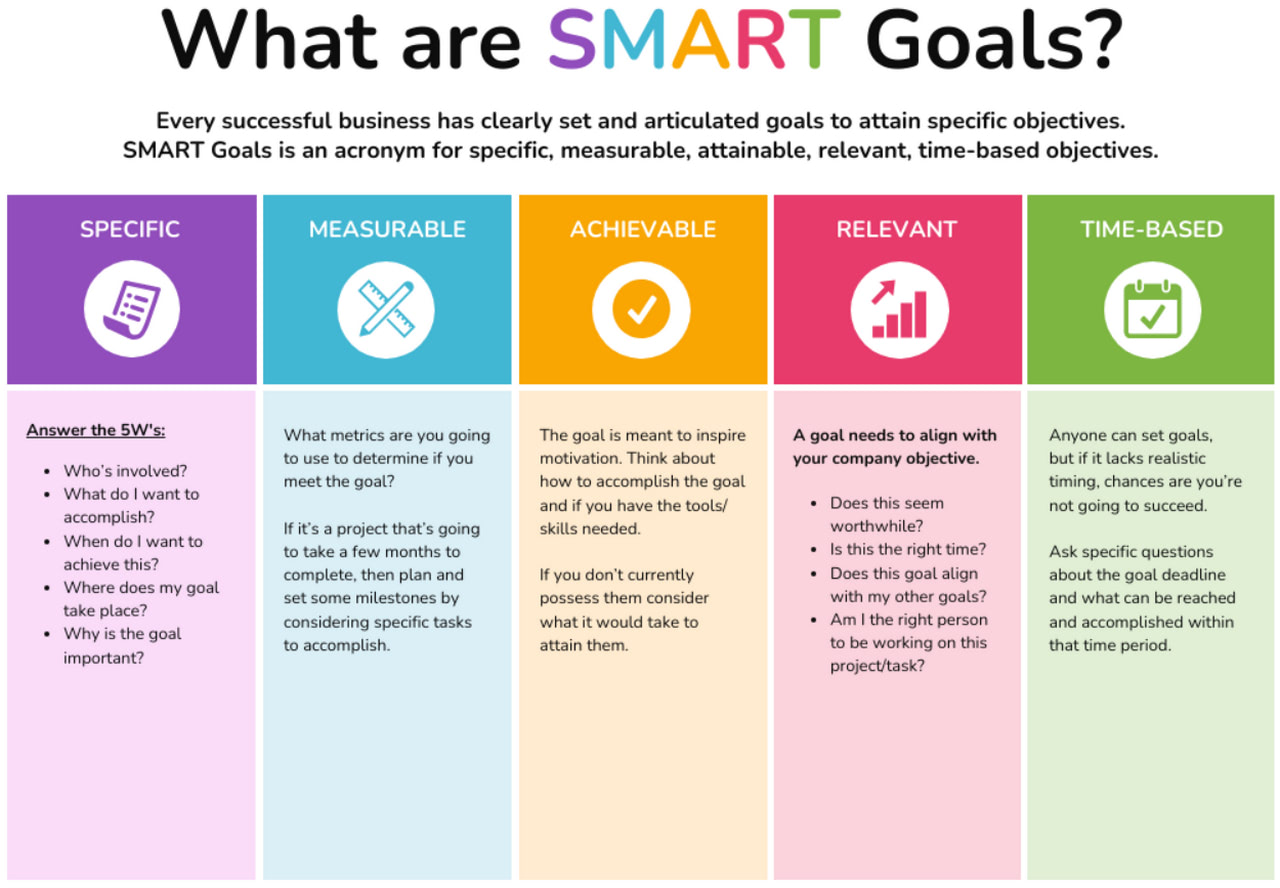
S.M.A.R.T. goals (infographic by Venngage)
Step 3 – Research Target Audience
Whether you intend to share your knowledge and experience or are eager to expand your expertise in a sphere driven by a paid newsletter model, understanding your target audience’s needs, preferences, and expectations is the critical step toward success.
Knowing your consumer base from the outset lets you reduce risks even during your pre-launch stage. It reveals opportunities and limitations for serving the right content, gaining new subscribers, and keeping loyal fans in the loop.
Start by gathering demographic and psychographic data. This might include age, gender, location, professional background, occupation, wealth, interests, hobbies, habits, preferences, expectations, attitudes, lifestyles, and everything relevant to your topic and goal.
Then, analyze market trends and mainstreams. As you gain a sense of the specific market share, you will better understand what will impact your way to success.
Finally, answer these questions:
- Is there a demand for your paid newsletter?
- How many people would be interested in your paid newsletter?
- Where and how can you reach your potential subscribers?
- How tough is your competition?
- How much do your competitors charge?
The best way to research your target audience and market is to use professional platforms. It would also help if you create surveys, questionnaires, and interviews to get direct answers from your target audience.
Ultimately, you should have enough information to create detailed audience personas. These personas will become cornerstones for all your efforts, starting with segmentation and ending with the choice of email design.
Step 4 – Decide on Your Topic
In-depth research of your target audience and competition provides you with crucial knowledge to make educated decisions about your topic. Sometimes, your skills and experience are insufficient to ensure the success of paid newsletters. Extending your knowledge and expertise is crucial to meeting your target audience’s needs.
To find your ideal topic, follow these steps:
- Consider your knowledge, skills, and experience. Identify your interests, passions, and hobbies. Clearly define topics aligned with your expertise and strengths.
- Research the niche. Find gaps that you might fill and select topics that excite you.
- Assess the long-term viability of your options. Are they passing trends or have lasting relevance? Are they seasonal?
- Define a unique perspective on the topic. What kind of material can you provide your subscribers that is worth their money? Will it separate you from the competition and underlie a strong foundation for personal brand building? Will it help to establish you as an expert?
When settling upon the topic, bear in mind these professional pieces of advice:
- Ensure the topic is narrow enough to stand out.
- Ensure the topic is diverse enough to offer long-term viability.
- Ensure the topic is flexible and scalable.
- Ensure the topic excites you and inspires on uncovering its hidden gems.
Step 5 – Decide on Content and Email Design
With purpose and topic on board, the time has come to decide on paid newsletter content. Design and body copy of your email are crucial details that deliver the message in a digestible form and produce a pleasant experience and lasting impression. Therefore, you need to work this out.
Content
Content is the cornerstone of your paid newsletter and why subscribers pay monthly fees. So, it must be perfected from every angle. Ideally, you should balance sharing knowledge and satisfying users’ pain points. You must step into their mindsets, pay attention to their cultural narrative, and craft a message that brings value and promotes you as an expert.
It is highly recommended that an email content strategy be devised. In general, this includes these steps:
First, decide on the type of content you want to send. The good news is that you can take dozens of routes when creating email content. It could be pure text, visuals, surveys, infographics, interactive components, or games. Remember that you might need different types of content for different audience segments (personas) and goals.
Second, compile a list of topics your subscribers are highly interested in. Review them for quality and relevance. Prioritize those options that receive a fair number of monthly searches or were asked directly by your target audience.
Third, create a content calendar to carefully plan, coordinate, and execute your content strategy. Use it to describe every detail, including topic, title, content type, status (writing, recording, editing, etc.), and due date.
Finally, monitor your content’s performance to measure your strategy’s impact.
Design
Design is another pillar of a successful paid newsletter. It brings numerous benefits when created with the subscriber preferences in mind and sprinkled with the creator’s brand personality.
Email design goes beyond visuals. It can affect user experience, first and last impressions, and the emotions that subscribers experience while interacting with content. It also supports the message, draws attention to key details, adds meaning, and inspires trust and credibility. It is the main tool for delivering the message, promoting your expertise, and building a strong personal brand identity.
Whether you operate in a serious fin-tech sector or not, you may benefit substantially from creating modern, branded, eye-pleasing designs tailored to your target audience’s preferences.
The good news is you do not need any special skills for that. Neither should you hire a dev team. Postcards, the best email builder in the niche, provides you with a super-intuitive and super-productive environment to create any email design you want. It comes with over 100 hand-crafted design blocks that you can mix and match to deliver the message your way. On top of that, you can employ one of its ready-to-use templates and kick-start your paid newsletter immediately.
With Postcards, you may rest assured that your email looks and works consistently across devices, operating systems, and mailbox providers, as every layout has well-thought-out, responsive, mobile-friendly behavior packed with accessibility features.
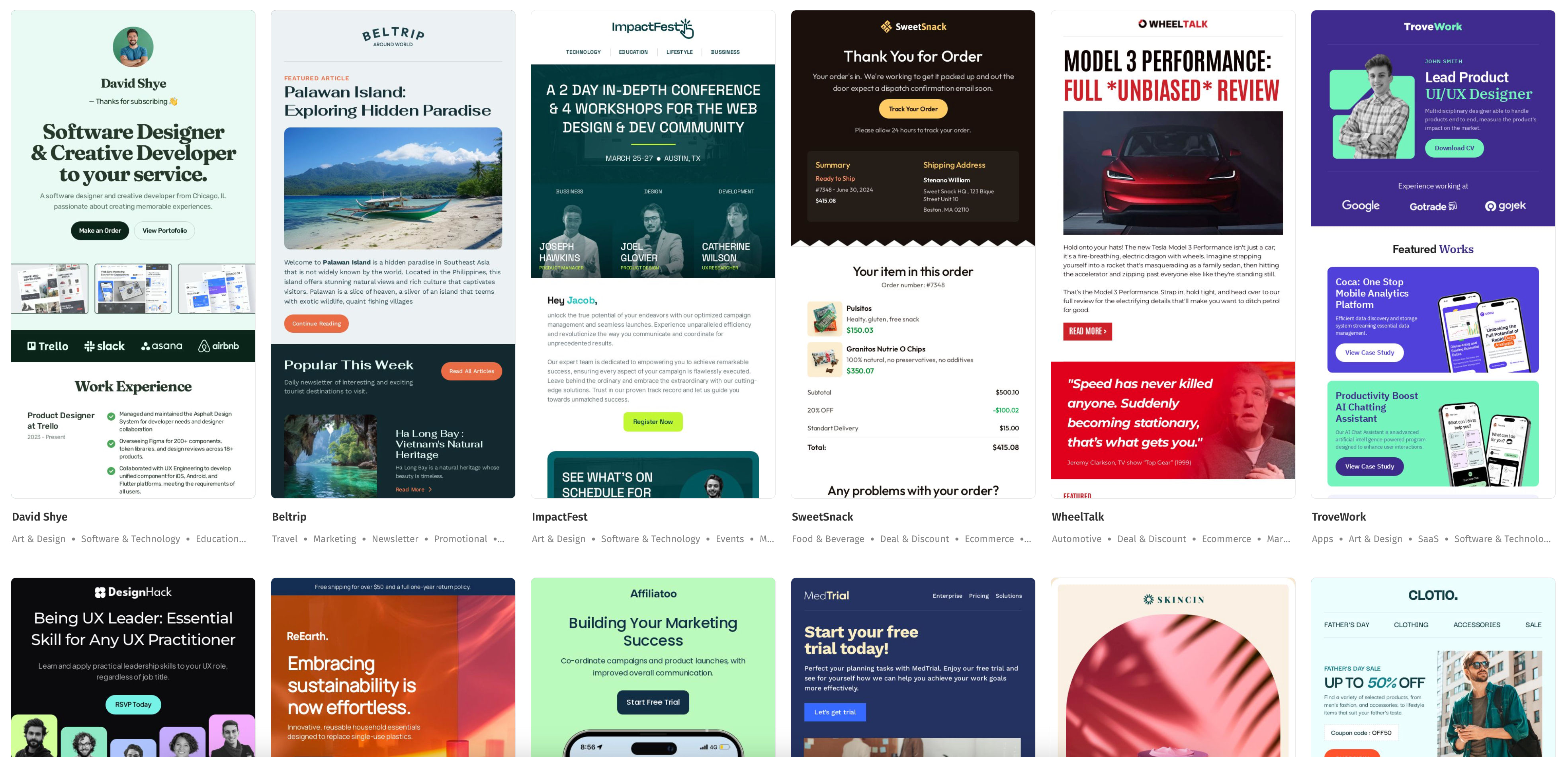
Free email templates by Designmodo
Step 6 – Create a Schedule
Time management is at the core of a successful paid newsletter business. By carefully planning and prioritizing your tasks, you can complete important projects, meet deadlines, and use your time more wisely. Effective management increases productivity, improves focus, underlies high-quality work, and decreases anxiety and stress, crucial to increasing your confidence and enjoying your professional life.
With a well-devised schedule, you will better allocate resources, set aside time for creativity, and, most importantly, meet subscriber expectations by delivering valuable content on time. It also helps to deliver consistently, translating into a great reputation and strong personal brand identity.
Start with deciding on the frequency of your paid newsletter. How often should you send content to your subscribers without overdoing it and getting burned out? The frequency should be manageable and flexible to keep your subscribers engaged. It could be daily, weekly, bi-weekly, or monthly, as long as you can produce high-quality content.
Then, determine the right sequence for your paid newsletter. Do not bore your subscribers down with the same content format. Enrich their experience with different types of content. You may use infographics to share recent stats, create videos, or send insider tips as a listicle.
Finally, determine the best time to reach your subscribers. Segmentation can help you do this and provide the necessary knowledge to create hyper-personalized outreach.
Step 7 – Gear Up with Professional Software
Running a paid newsletter includes many tasks. From researching quality content to creating eye-pleasing branded email design to gathering crucial insights on your performance, you cannot do everything manually. Specialized software is what you need to run your business smoothly, stick to your schedule, and reach your goals efficiently.
Email service providers, email builders, deliverability checkers, analytical tools, and other professional instruments allow creators to grab every opportunity to forward their business. They help acquire subscribers, monetize subscriptions, segment audiences, create hyper-personalized outreach, optimize email deliverability, and automate routines, providing the necessary time for creativity.
The web is teeming with specialized email marketing software. Find the best option to fit your budget and current needs.
Whether you already have a mailing list of free subscribers who might be turned into premium members or build one from scratch, you must promote your paid newsletter. There is no better way to do this than to craft a landing page. It is a popular, reliable, and time-tested solution for conversion.
As the initial point of contact between your business and a visitor, it underlies successful lead generation. It is the promotion paradise that lays out the value your paid newsletter can offer. Apart from culling qualified leads from search traffic, it builds credibility, cultivates trust, and inspires loyalty.
There are numerous ways to create a landing page. However, a website builder is the most effective, reliable, and time-effective. Take Startup, a free professional Bootstrap builder for landing pages. It will do all the heavy lifting for you. Its user-friendly drag-and-drop interface is perfect for assembling the promo landing page that reveals the value of your paid newsletter.
You may also adopt alternative ways to promote your paid newsletter to maximize the impact. They are:
- Get recommended by other creators or partner with influencers.
- Introduce a referral program, run a giveaway, or offer a gift.
- Mention paid newsletter in blog posts, course materials, video channels, interviews and podcasts, and author byline.
- Strategically place opt-in forms throughout your main website and create an exit-intent popup.
- Repurpose content to cross-promote across social media.
- Guest posts on authority sites and participate in podcasts and interviews.
- Use paid advertising.
Step 9 – Retain Subscribers and Build a Community
The key to long-term success with a paid newsletter is retention. The value you provide doesn’t stop with the content itself—it’s also about building a sense of community. Engaged subscribers are more likely to remain loyal, and you can reduce churn by maintaining regular interaction.
Retention Tips
- Engage Readers: To create a deeper connection with subscribers, send personalized emails, ask for feedback, and offer Q&A sessions.
- Exclusive Benefits: Offer perks like member-only events, live webinars, or special giveaways.
- Community Building: Create private discussion groups (e.g., Slack, Discord) to give subscribers a place to connect and discuss topics from your newsletter.
Pro Insight: “Creating a strong community around your newsletter is crucial. It’s not just about content but also making your readers feel like they’re part of something bigger,” says Emma Davies, a community-building expert.
Step 10 – Measure Success and Iterate
The final step to scaling your paid newsletter is measuring performance and optimizing your strategy. Analyze key metrics, such as open rates, click-through rates, and subscriber growth to understand what resonates with your audience.
Key Metrics to Track
- Open Rates: Measure how engaging your subject lines are.
- Click-Through Rates: See how often subscribers engage with your content links.
- Churn Rate: Monitor how many subscribers cancel their subscriptions and why.
Expert Tip: “A/B test subject lines, content formats, and offers to continuously refine your paid newsletter strategy. Your audience’s preferences will evolve, and you should adapt accordingly,” advises Michael Harper, a digital marketing strategist.
Conclusion
Starting a paid newsletter can be a highly rewarding way to monetize your knowledge and build a dedicated audience. Following these expert-backed steps—from choosing the right niche to building an engaged community—will set the foundation for a successful paid newsletter subscription. Now’s the time to turn your expertise into a thriving business model. Get started today and join the ever-growing list of creators who have transformed their passion into profit. This article incorporates practical strategies, expert insights, and real-world examples to position your paid newsletter as a credible and authoritative source.
Despite massive free content influx and AI bots answering every question you have, people are more than ever craving high-quality, authentic, and exclusive knowledge. Launching a paid newsletter to share your expertise with them is one of the best ways to meet these needs.
A paid newsletter opens many opportunities for personal and professional growth. It helps establish yourself as an expert, build community, and turn your personality into a brand. Plus, it provides much-needed recurring income that supports your passion and allows for self-improvement and self-development.
Starting a paid subscription business does not require technical skills or a huge budget. The entry level is low: anyone can do that. However, it comes with certain challenges. To overcome them, creators should devise a strategy and consistently deliver valuable content. They should also exercise creativity to keep their audience engaged and interested in communication and adapt to trends and needs to stay on top of the game.
